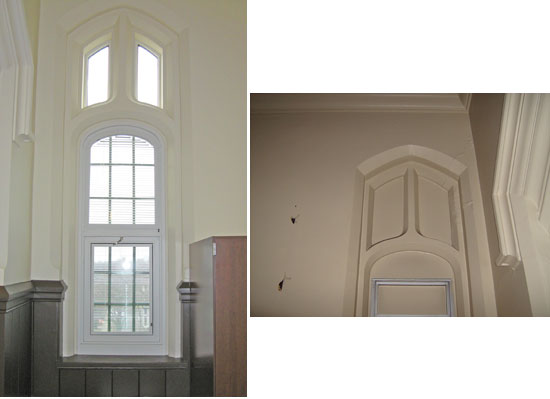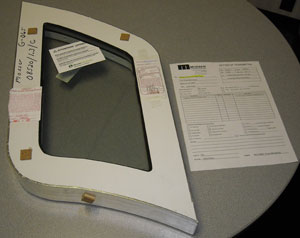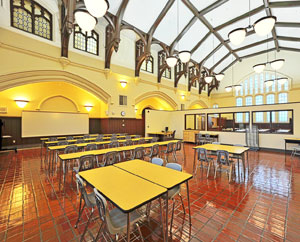Performance Plus: Quality Makes a Difference When Specifying Aluminum Fenestration Products
![]() Continuing Education
Continuing Education
Use the following learning objectives to focus your study while reading this month’s Continuing Education article.
Learning Objectives - After reading this article, you will be able to:
- Discuss the key energy codes and standards that influence the architectural aluminum fenestration selection.
- Specify the appropriate fenestration product type(s) for different building types and applications.
- Explore ways to ensure proper installation for optimal performance.
- Determine how architectural aluminum fenestration products can contribute toward LEED® points for projects.
Confronted with the alphabet soup of codes, standards and green building measurements, the architect selecting aluminum fenestration for a commercial project may need help to understand the key elements of high performance windows. The decisions that influence window, curtain wall, and storefront selection require knowledge of structural, thermal, safety, visible transmittance and even acoustic properties. A review of major industry standards will provide an overview for the architect specifying the appropriate fenestration product for their next project. This article will also review the problems to avoid when selecting quality aluminum windows, curtain walls and storefronts.
Aluminum windows, storefronts and curtain walls can be specified for many market segments. High performance aluminum windows are becoming a standard in commercial markets from schools to retail stores. Architects are specifying aluminum windows for replacement windows in historic schools, for auto dealerships, government and public projects, manufacturing and industrial buildings as well as for major hospitals and in healthcare settings. They are choosing aluminum fenestration products for their versatility as well as for providing window systems along with high performance glazing that are affordable, durable and sustainable.
Properties of Aluminum Frames
There are many benefits to using aluminum frames for windows, storefronts and curtain walls. Finished, lightweight aluminum is resistant to weather, common atmospheric gases and a wide range of liquids. Aluminum alloys have a high strength to weight ratio and can meet or surpass the strength of common steel construction. Aluminum retains its strength even in cold temperature. Aluminum has an attractive, durable anodic finish and can be painted to match any application. Aluminum can contribute points toward LEED ® projects as aluminum window extrusions can contain as much as sixty – percent or more recycled content. It is recyclable and aluminum building components can be repeatedly recycled back into similar products with no loss of strength.
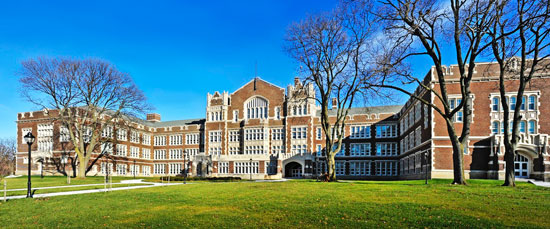 |
High Performance replacement windows added value and met LEED ® goals for Toledo's Jesup W. Scott High School Renovation. Photo by Edmond S. Oliveros Design & Illustration |
Choosing Aluminum Over Wood Or Vinyl
There are many pros and cons to choosing aluminum over wood or vinyl as a frame material. Aluminum is lightweight and has 1/3 the weight of steel with exceptional strength to weight ratio. This means that lightweight aluminum can span longer distances using less material providing design advantages to the assembly and installation particularly in larger commercial projects. Aluminum frames are ideal for large openings and provide numerous structural advantages. Aluminum is corrosion resistant and requires little to no maintenance. Aluminum is long lasting and durable with an estimated life cycle between 20 and 50 years. Anodized aluminum has an attractive appearance that is durable and resistant to weather. It can be painted as specified to work within any color scheme or match any application.
When specifying aluminum, the design professional is using a product that can be both recycled numerous times without losing its initial strength. Aluminum can also be specified with recycled content and using aluminum can contribute to points in a variety of green rating systems.
On the other hand, wood frames, although they come from a natural resource, can only contribute to green rating systems if the wood product is selected from either a rapidly renewable wood product or specified from an FSC managed forest. Wood is often chosen because it is also not corrosive and for its natural appearance, however, to retain that natural finish requires maintenance that is often not an advantage for a commercial product.
Vinyl frames are also noncorrosive and require less maintenance than wood, particularly in the right climate. However, vinyl frames are prone to discoloration over time. They are not as structurally stable as an aluminum frame and can warp, bend or crack. Vinyl products are not readily recyclable and usually are produced from toxic materials and processes. In addition, vinyl frames like wood frames have a short life cycle from as little as 10 to as much as 30 years.
Thermal Resistance, Condensation and Air Infiltration
The American Architectural Manufacturers Association (AAMA) is a collection of manufacturers of many fenestration systems, test labs and suppliers. They provide both certification labels and set standards for quality fenestration products. The AAMA provides a standard specification for North American Fenestration Standards, AAMA/WDMA/CSA101/I.S.2/A440-08. In October 2012, The AAMA published QAG-2-12, the “Voluntary Guide for Polyamide Thermal Barriers.” This guideline covers a wide range of issues that affect the quality of polyamide structural thermal-break systems used in aluminum frames. Polyamide thermal barriers are comprised of an extruded thermoset material composed of a strong, durable polymer reinforced with 25 percent of glass fibers for use in fenestration systems such as curtain walls, storefronts, windows, doors and skylights. A fenestration system that meets the AAMA 1503-09 “Voluntary Test Method For Thermal Transmittance and Condensation Resistance of Windows, Doors and Glazed Wall Sections” is one that has improved infiltration rates as well as condensation resistance factors.
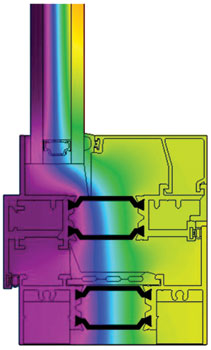 |
Section cut of an aluminum thermally broken frame demonstrating the prevention of cold air “bridging” into the interior. Illustration by Capitol Aluminum & Glass Corp. |
Metal conducts cold air and unless a frame has a combination of air gaps and insulation, cold or hot air is transferred across the metal “bridge” into the building. This transfer of cold air reduces the energy efficiency of the entire window system. It can also cause condensation. When the interior window frame is colder than the inside air, condensation can occur. Quality aluminum frames are constructed with a combination of aluminum with a thermal conductivity of 210 Watts/mass Kelvin (W/mK) and Polyamides with a conductivity of 0.3 W/mk. The polyamide thermally broken frame is 40 to 70 percent less conductive than non-insulated frames. An energy efficient aluminum frame combined with glass with low U-values provide thermal performance values that can meet ASHRAE 90.1 - 2010, the most recent standard that provides minimum requirements for energy efficient design for buildings except for low-rise residential buildings.
A window system must also be resistant to water penetration as well as air leaks. Several test standards are met by a quality window system. Included among these is the American Society for Testing and Materials (ASTM) material tests.
- ASTM E331-00 (2009) Standard Test for Water Penetration of Exterior Windows, Skylights, Doors and Curtain Walls by Uniform Static Air Pressure Difference.
- ASTM E283-04(2012) Standard Test Method for Determining Rate of Air Leakage Through Exterior Windows, Curtain Walls, and Doors Under Specified Pressure Differences Across the Specimen.
- ASTM E 547 Standard Test Method for Water Penetration of Exterior Windows, Skylights and Curtain Walls by Cyclic Static Air Pressure at the face higher than the pressure at the indoor face.
The first and second bullet points test the resistance of the entire assembly of the fenestration to resist water when applied to the face of the products under various conditions. The third test includes the performance of the entire wall system and wall performance, proper installation and adjustment.
Security
Aluminum frames provide greater levels of security than vinyl or wood windows and should be chosen to meet the appropriate security tests. AAMA 1302.5 and ASTM F588-07 are the test standards developed to meet the concerns of law-enforcement officials and the public for greater levels of safety. These standards apply to the assembly of the frame and set guidelines for the resistance of window assemblies to forced entry.
Noise Abatement
Sound transmission through building wall components, including windows are tested in the laboratory and rated according to ASTM E90. Measure E336 is used to test the apparent sound transmission loss of the component in the field. Aluminum frames outperform vinyl in noise abatement due to the mass of the frame. Thicker aluminum frames prevent sound transmission. Vinyl frames have very little mass and sound is easily transmitted through vinyl versus other types of frame materials.
Most architects are familiar with Sound Transmission Class (STC ratings) which is a single number rating for interior partitions subjected to noise from speech, electronic media such as televisions, and the other mid to high frequency sources. An STC rating is calculated according to the ASTM E413 standards and the higher the number the better the acoustic properties of an interior wall. These ratings are based on lab tests and the number is affixed to the products either as a label or as part of a material data specification sheet.
An Outside Inside Transmission Class rating differs from the STC rating as it provides a single number rating for exterior walls and facade elements such as windows and doors. Exterior elements are typically subjected to transportation noises from automobiles, trains, emergency vehicles and airplanes and other low to mid-frequency noise sources. The OITC is calculated according to the ASTEM E1332 standard and is tested both in the field as well as in a laboratory.
Sound transmission loss values from the ASTM E90 test are used to calculate the STC and the OITC ratings and this standard should be included in projects that require noise abatement such as urban areas, educational classroom areas, and health care environments.
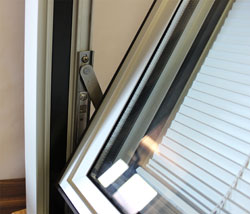 |
European hardware systems are durable options for many commercial applications. Photo by Capitol Aluminum & Glass Corp. |
Durable Window Hardware
A recent advancement to North American window systems includes new, durable hardware systems that are clamp fit to lock out cold air. These European systems also known as Euro-groove, allow the window to be opened by a variety of means. Slide and lift, tilt and turn or fold and slide doors are some of the alternatives for these new window and door hardware options. This hardware is typically designed into grooves in the window frames and the locking points are located around the perimeter of the sash. Because the profiles of these hardware systems are usually thicker than other hardware systems, they are a durable and more reliable option for many commercial applications thus reducing the need for the typical 1/8” aluminum wall requirement.
Windows, Curtain Walls, and Storefronts
An intelligent way to value-engineer or design a building system is to select the proper fenestration system. A good window manufacturer can review a project in the early stages of design to find alternatives for cost savings. Curtain walls along with all building components are designed to withstand wind loads, dead loads and other imposed reactions and are usually selected for large openings. The project engineer is responsible for calculating wind loads, not necessarily the window manufacturer. Curtain walls are designed to meet many parameters, from thermal efficiency to structural integrity. Numerous structural systems can be used to support a curtain wall and it is critical to understand the right structural system that meets requirements for dead and live loads as well as maximum deflection lengths.
There are new aluminum codes that have revised the criteria for considering the unbraced length of open sections in curtain walls. This new technical bulletin released by the American Architectural Manufacturers Association, the Window and Door Manufacturers Association, Fenestration Manufactures Association and Door and Access Systems Manufacturers Association relates the ASCR/SEI 7-10 design wind loads to fenestration product ratings. This bulletin updates the industry on the aspects of testing exterior fenestration products. Structural requirements for engineering in the design phase should be clarified before selecting a curtain wall or storefront project application. An AAMA proposal clarifying the allowable stress wind loads are to be used in the application of AAMA/WDMA/CSA 101/I.S.2/A440, DASMA 108 and ASTM E330 are just one of the key proposed changes for the 2015 International Building Code.
The choice of window, storefront, or curtain wall structural systems for larger openings can pose a dilemma for many design professionals. Structural requirements, energy efficiency, aesthetics and cost are just some of the values to be evaluated. Window and curtain wall systems offer great water resistance and can be utilized in low, mid, and high-rise applications. Storefront systems are generally more affordable but can also be more limited when used in low-rise applications. It is important to review the specific project’s structural requirements when selecting a window, curtain wall, or a storefront system. Consulting a representative or project service individual from the architectural aluminum manufacturer will help to ensure that the correct product application is incorporated in the project.
As seen in the following case study, selecting the proper aluminum fenestration products, windows, curtain wall, and storefront systems with good thermal properties are important to the development of successful and sustainable decisions for commercial construction projects.
| Fenestration Challenges: Historic Jessup W. Scott High School High | ||||||
When discussing the renovation of Toledo’s Scott High School, Kevin Costello, AIA, architect with SSOE Group, comments, “Windows can present a high percentage of the exterior wall area. Maximizing the energy efficiency of that area is important when renovating a school with sustainability goals.” Costello speaks from experience as the many windows in this high school renovation included a large percentage of the entire exterior wall. His goal was to maximize the thermal efficiency of the windows to increase performance while maintaining the historic appearance of the schools original design for the community. All architects who work on schools in Ohio must follow the Ohio School Design Manual developed by the Ohio School Facilities Commission to guide all school projects. These guidelines encourage renovations to meet as a minimum, the goals for LEED ® Silver certification. More on the OSFC guidelines are provided as a side bar at the end of this article. This project included large hopper, awning, and fixed windows as well as storefronts, curtain walls and entrances. Many of the classroom windows were over ten feet high by over three feet wide and required custom solutions. The aluminum windows that were selected met the Ohio guidelines that required a 1/8” thermally broken window “wall” section. The architects specified a U-value of 0.45 maximum although more thermal properties were obtained as an additional interior glass panel was added to the frame opening. The custom energy efficient windows all were specified with low-E glazing and the results maximized the thermal efficiency of the existing wall systems. Many of the original windows in the school were removed previously, but the architect was able to look at old photos to replicate the original muntin/grid configurations. The architect preserved the historic look of the building along with a window that had integral blinds to control glare into the classroom. The large restored windows contributed to the daylighting credits for the project’s LEED ® submittal. Integrating daylight into school buildings is part of many green schools criteria because of the beneficial impact of daylight on performance. In the dining room and the gymnasium, larger openings were specified as storefront framing with 1” insulating obscure glass. For this project, SSOE Group specified aluminum fenestration from a manufacturer who also acted as an informational design resource. This manufacturer was responsible for the installation as well as the production of the windows, curtain walls and storefronts used for the entryway. The advantages of this strategy included the ability of the architect to turn to the manufacturer for advice on alternatives and direction on custom and suitable solutions throughout the project.
The architectural aluminum manufacturer submitted a reduced scale mock-up for the panels that were to replace the ornate openings in the gothic art room windows. This mock-up allowed the architect to choose the most suitable, structurally sound, and aesthetically accurate alternative for the project. The architect was able to detail the sub-frame attachments to the one hundred year old walls with the assistance of the window consultant. The architect discussed the advantages of using curtain wall versus storefront in various areas of the building and in some areas chose storefront as a cost effective alternative that still allowed him to emulate historic fenestration. Costello notes that “the technology on windows is constantly changing and a good architectural aluminum manufacturer can keep the architect up to date on the latest codes and materials while providing advice on cost and durability.” Jesup W. Scott High School in Toledo, Ohio was named for a 19th century editor of the Toledo Blade newspaper. Originally built in 1913 and designed by architect David L. Stine in collaboration with Edwin M. Gee, this three story collegiate Tudor gothic School is listed as a contributing structure to Toledo’s West End Historic districts. Renovating this historic building involved meeting a number of challenges for SSOE Group the architectural firm that has received Ohio’s annual award for the “ Best Public /Private Partnership for this project.” The architect’s met with numerous community groups, the public, the “”Save Our Scott” committee, and Toledo’s Historical West End District to lead the successful renovation of this important structure. The current school building totals nearly 285,000sf and the renovation included the dining room, auxiliary gym and auditorium as well as athletic fields. Demolished materials from the project were re-used, including the quarry-tile flooring. New electrical and mechanical systems, new lighting, low-flow plumbing and new windows also contributed to the LEED® documentation. By updating the existing school, the building has continued to be part of the cultural context in the community and taken advantage of some of the best attributes of the original design. The original design included large windows that provide daylighting and solar control plus fresh air into the classrooms.
|
Performance Compliance – Substitutions
Design and building professionals are always seeking the most efficient and cost-effective way to complete a successful project. First costs may seem like a valid criteria for the selection of products, however, recently life – cycle assessments are proving that it is better to select fenestration that are durable, meet high performance values and will lower overall energy costs. Some guidelines to choosing high performance fenestration and to avoid alternatives to a specified material or installation include:
- Review quality of window and/or frame substitutions. Do the “or equal” substitutions actually meet the testing and performance data? Sometimes a window and frame may have the same dimensions as the specified product but not the required performance values.
- Review the size, thickness, and make-up of glazing in-fills that are to be installed in the window, curtain wall, or storefront frames. If the specified infill is not the correct thickness, and make-up, it will not fit in the frame and typically not meet the specified performance values.
- Require a licensed professional engineer’s review and/or the requirement of stamped calculations of the shop drawings at the submittal stage of the project.
- Carefully review windows in the field to assure that they do meet shop drawings. Verify the thickness of the glass as well as the size of the frame. Sometimes insulated units with ¼” glass are substituted with 1/8” glass units. Snap trim may mask a narrower profile of window frame and should be checked before installation. Require that the installer leaves the manufacturing label on the glass during installation to verify the glass type and make-up ensuring compliance with project requirements.
- Ensure proper installation for optimal performance and know that sub-standard installation practices can include poor air barrier coordination and application. Improper or missing perimeter insulation will compromise performance.
- Guarantee an airtight fit and avoid water leakage by using the AAMA 503-08 Voluntary Specification for Field Testing of Newly Installed Storefronts, Curtain Walls and Sloped Glazing Systems which evaluates the installed performance of fenestration prior to the installation of the building occupancy permit but no later than six months after the issuance of the occupancy permit.
An effective way to avoid construction headaches is to specify a fenestration product from a single source provider. A fenestration system that is manufactured and installed by a manufacturer-approved installer assures better quality control.
- Factory fabrication to meet design specifications and quality adherence.
- Production of manufacturer-produced shop drawings or from a manufacture-approved shop drawing service. These include references to manufacturer’s standard quality codes and installation instructions to ensure proper interpretation and coordination of substrate conditions.
- Mockups and field testing of components and as seen in the Jessup W. Scott High School example allows for the production of alternatives for cost and quality evaluation.
- Finish consistency.
- Manufacturer’s installation certifications, warranties and closeout documents.
- Reduction of administration/coordination for the architectural engineering firms.
- Coordination of shipping, handling and scheduling from a single supplier.
- Current code evaluation of the product and design to assure quality and compliance.
- Ensures that the specified aluminum fenestration systems installed match what was specified and submitted through the front-end submittal process including the proper review and verification of test reports, shop drawings, and close-out documents, etc.
There are many advantages to specifying a product from a single source provider. More buildings are being designed to meet green rating systems including USGBC LEED® certifications supplying one more reason to choose a single source supplier. A single source provider is able to track the content of recycled materials and high performance glazing products more efficiently for the design professional.
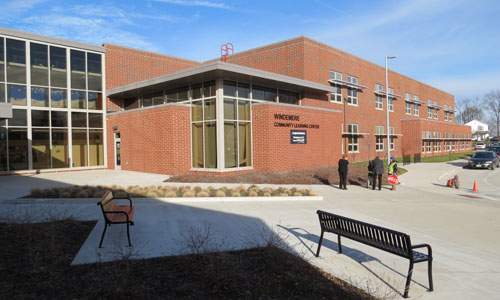 |
View of front entryway of Windemere Community Learning Center designed to meet LEED ® Silver certification and incorporated many integrated daylighting design techniques. Photo by Braun & Steidl Architects |
Sustainability and LEED®:
There are many ways in which a high performance fenestration system can be a contributing factor to meeting LEED® criteria. Architects and owners can benefit in these three main categories. Energy & Atmosphere (EA), Materials and Resources (MR) and Indoor Environmental Quality (IEQ).
To meet criteria in EA Credit 1: Optimize Energy Performance, fenestration should meet the guidelines in ASHRAE 90.1. Window glazing should be selected with low U – values and quality frames should prevent heat loss/gain through insulation and prevention of thermal bridging. Additional thermal performance can be obtained with sunshade and glare devices such as integral blinds and light shelves which add to credits in IEQ. Integrating photovoltaic’s into a curtain wall, sunshades or in conjunction with glazing infill’s can also contribute to points in EA CREDITS 2.1-2.3. On-Site Renewable Energy.
Aluminum extrusions can be specified with as much as 60 percent recycled aluminum by weight and can contribute to MR Credits 4.1 and 4.2 Recycled Content. Before counting on this additional material credit, the architect will need to assure that the window manufacturer can supply the appropriate source documents. If selected from a source manufactured within a 500-mile radius of the project, the architect can also obtain credits for using regional materials, MR CREDITS 5.1-5.2.
Designing high performance windows are a major part of controlling thermal losses in a building. They also contribute to integrated design strategies for Indoor Environmental Quality. Operable windows with quality hardware contribute to EQ Credit 2.0 Increased Ventilation. Operable windows add to thermal comfort particularly if the occupant of the building has control not only of opening the window, but also of adjusting the blinds to prevent glare. Choosing an integral blind system reduces maintenance in a commercial setting and maximizes the control of glare to contribute to EQ Credit 6.2 Controllability of Systems. Lastly, an understanding of how to integrate passive solar strategies, daylight, the control of glare with good thermal performance, and provide views to the outdoors meets EQ Credit 8.1-8.2.
Project architect John Wheeler AIA, LEED BD+C, understands the value of daylight to great learning spaces. “Its imperative for classroom performance that good quality window and glazing selection is made to control glare and allow natural lighting to go deeper into the room. Room proportions and layouts are critical for providing natural light. You can’t just put large windows in a room and not control glare.” A description of his daylighting strategies for the Windemere Community Learning Center provides a model for integrated daylight design.
| Daylight Strategies and Windemere Community Learning Center | ||
An aggressive 15 year commitment to neighborhood and community development in Akron Ohio has resulted in new schools designed to LEED ® Silver standards. Designed by Braun & Steidl Architects The Windemere Community Learning Center (CLC) is a new contemporary 54,545 square foot elementary school (K-5) that will accommodate 250 students as well as serve as the focal point for the surrounding neighborhood. Windemere CLC is located on 4.24 acres in east Akron Ohio. The building was oriented to take advantage of daylight and views to enhance the green space and pedestrian plus vehicular circulation around the school. The design seeks to create an educational environment that is inviting for students and an attractive addition to the community. On the South side of the building, large eight-foot high windows are divided into a lower vision pane and an upper daylight panel. The lower, five-foot high windows were specified with high performance glazing u-values of 0.27. The tempered glazing reduced glare at eye level with a 42 percent visible transmittance. The upper, three-foot high windows allowed daylight to extend deep into the room with a 70 percent visible transmittance. The operable classroom windows have integral blinds allowing for individual daylight controls. The architect calculated the solar angles and combined a series of light shelves along with sloped classroom ceilings to bring daylight far into the interior. Some of the shading devices are attachments to the wall rather than the windows that allowed them greater freedom when detailing these large windows. Even larger windows were designed for the North side of the building to allow more natural light into the art rooms. In order to meet LEED® targets for the project, the architect specified windows with high thermal performance. Window and curtain wall frames used in the building were 1/8” thermally broken members and the glazing met a U factor of 0.29 for winter night and a 0.27 for summer day. These daylight strategies allowed Wheeler to introduce the largest amount of daylight without sacrificing energy efficiency. Braun & Steidl have developed a stringent review and shop process to assure quality products for their projects. |
| High-Performance Green School Requirements in Ohio |
In 2012, the offices of the State Architect and the Ohio School Facilities Commission were merged to become the Ohio Facilities Construction Commission (OFCC). This entity is responsible to guide all capital projects for state agencies, state-supported universities and community colleges. The OFCC is also responsible to coordinate construction and renovations for the public k-12 schools, providing extensive guidelines for school construction that encourages green schools. THE OSFC uses the U.S. Green Building Council’s LEED ® For Schools rating system as a “roadmap for documenting and measuring the progress of our Green Schools Initiative for high performing, energy efficient buildings.” Those schools that were funded for OSFC money after 2007 are required to meet at least LEED Silver and have the goal of meeting LEED Gold levels. The requirements for thermal performance include standards for windows that meet energy efficient standards. There are also requirements for commissioning and evaluations of the school buildings during and after construction. The architects who work in Ohio follow the Ohio School Design Manual which can be downloaded from a central website. The OSFC staff developed it with input from the design and construction community, school districts, state industry, architects and national experts in school design and planning. Evaluated and updated annually, the manual promotes 21st century learning environments and provide flexible guidelines. This document encourages the use of high quality materials and systems that will maximize the life-cycle value of each building. |
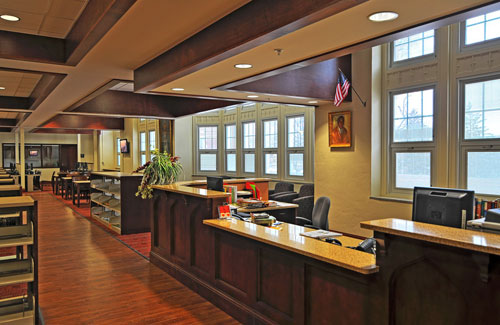 |
High performance windows can help make a historic building energy efficient as seen in this Toledo high school. Photo by Edmond S. Oliveros Design & Illustration |
Choosing The Right System
Quality makes a difference for thermal performance as well as life cycle analysis when choosing a fenestration system. Many variables influence the design professional’s decisions. Common practices and rules of thumb for selecting a type of window or fenestration product for a specific commercial project may no longer apply. Now windows, curtain wall, and storefronts systems are being combined and incorporated in a large variety of commercial project applications.
New codes, green standards and optimal maintenance criteria all can combine to make the choice for the appropriate windows more complex. As an example, integral blinds, and a variety of window treatments based on building orientation are means to provide better comfort control and reduce maintenance. New hardware systems and highly engineered thermally broken aluminum window frames contribute to LEED® credits and maintain the integrity of the thermal envelope. As the choices are multiplied, finding a quality manufacturer and installer up to date on codes, regulations and the latest in green strategies is important. From educational projects, hospitals, to automobile dealerships, selecting high performance fenestration products has never been more important as the cost of energy rises. Design professionals continue to search for optimal strategies to provide comfort control. Selecting a high performance fenestration system is an important means to provide quality to any commercial project.
 |
Capitol Aluminum & Glass Corp manufactures and distributes various types of energy efficient aluminum window, entrance, storefront, and curtain wall systems and is equipped with specialized automated production equipment for cutting, machining, and assembling aluminum extrusions. http://www.capitol-windows.com |

